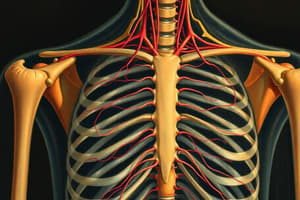Podcast
Questions and Answers
What effect does the sympathetic autonomic nervous system (SANS) have on the heart?
What effect does the sympathetic autonomic nervous system (SANS) have on the heart?
- Has no effect on heart rate or contraction strength
- Increases heart rate and strength of contraction (correct)
- Decreases heart rate and strength of contraction
- Increases heart rate and decreases strength of contraction
How does the parasympathetic autonomic nervous system (PANS) affect the bronchial tree?
How does the parasympathetic autonomic nervous system (PANS) affect the bronchial tree?
- Causes bronchoconstriction (correct)
- Causes bronchodilation
- Increases airway resistance
- Has no impact on airway lumen
Which autonomic system stimulates peristalsis in the esophagus?
Which autonomic system stimulates peristalsis in the esophagus?
- Sympathetic autonomic nervous system (SANS)
- Somatic nervous system
- Parasympathetic autonomic nervous system (PANS) (correct)
- Central nervous system
What role do visceral sensory (VA) fibers play in the thoracic autonomics?
What role do visceral sensory (VA) fibers play in the thoracic autonomics?
What does the SANS do to the airways?
What does the SANS do to the airways?
What type of information is carried by the visceral sensory fibers from stretch baroreceptors?
What type of information is carried by the visceral sensory fibers from stretch baroreceptors?
What effect does the SANS have on mucus glands in the lungs?
What effect does the SANS have on mucus glands in the lungs?
What is the primary function of the autonomic nerve plexus associated with the heart?
What is the primary function of the autonomic nerve plexus associated with the heart?
What type of innervation does the vagus nerve provide to the thoracic viscera?
What type of innervation does the vagus nerve provide to the thoracic viscera?
Which part of the spinal cord contains preganglionic neurons of the sympathetic autonomic nervous system (SANS) that regulate thoracic viscera?
Which part of the spinal cord contains preganglionic neurons of the sympathetic autonomic nervous system (SANS) that regulate thoracic viscera?
Where do the postganglionic neurons of the sympathetic system for thoracic organs originate?
Where do the postganglionic neurons of the sympathetic system for thoracic organs originate?
What is the function of the cardiac, pulmonary, and esophageal nerve plexuses?
What is the function of the cardiac, pulmonary, and esophageal nerve plexuses?
Which cranial nerve is associated with the parasympathetic autonomic nervous system (PANS) innervation in the thoracic region?
Which cranial nerve is associated with the parasympathetic autonomic nervous system (PANS) innervation in the thoracic region?
Which neurotransmitter is primarily released by postganglionic SANS neurons?
Which neurotransmitter is primarily released by postganglionic SANS neurons?
Where are terminal parasympathetic ganglia typically located?
Where are terminal parasympathetic ganglia typically located?
Which of the following correctly pairs the neurotransmitter with its system?
Which of the following correctly pairs the neurotransmitter with its system?
Where do preganglionic sympathetic axons synapse after entering the sympathetic trunk?
Where do preganglionic sympathetic axons synapse after entering the sympathetic trunk?
What is the role of postganglionic sympathetic axons in the cardiac plexus?
What is the role of postganglionic sympathetic axons in the cardiac plexus?
Which receptors mediate the effects of sympathetic stimulation on the heart?
Which receptors mediate the effects of sympathetic stimulation on the heart?
What is the primary effect of parasympathetic innervation on the heart?
What is the primary effect of parasympathetic innervation on the heart?
Where are the preganglionic parasympathetic neurons that innervate the heart located?
Where are the preganglionic parasympathetic neurons that innervate the heart located?
Which neurotransmitter is utilized by postganglionic parasympathetic fibers in the heart?
Which neurotransmitter is utilized by postganglionic parasympathetic fibers in the heart?
What type of nerves do postganglionic sympathetic axons leave the cervical sympathetic ganglia as?
What type of nerves do postganglionic sympathetic axons leave the cervical sympathetic ganglia as?
How does the sympathetic autonomic nervous system affect coronary arteries?
How does the sympathetic autonomic nervous system affect coronary arteries?
What effect do b2 adrenergic receptors have in the pulmonary system?
What effect do b2 adrenergic receptors have in the pulmonary system?
Which receptors are responsible for bronchoconstriction and increased mucus secretion?
Which receptors are responsible for bronchoconstriction and increased mucus secretion?
What physiological response occurs upon transitioning from a reclining to a standing position?
What physiological response occurs upon transitioning from a reclining to a standing position?
What causes orthostatic hypotension?
What causes orthostatic hypotension?
Which condition is associated with a loss of visceral afferents traveling through the vagus nerve?
Which condition is associated with a loss of visceral afferents traveling through the vagus nerve?
What is the primary role of chemoreceptors in the body?
What is the primary role of chemoreceptors in the body?
What happens to blood flow to skeletal muscle when there are increases in PCO2?
What happens to blood flow to skeletal muscle when there are increases in PCO2?
What is the primary function of the baroreceptor reflex?
What is the primary function of the baroreceptor reflex?
What is the primary role of the cardiovascular component of the chemoreceptor reflex?
What is the primary role of the cardiovascular component of the chemoreceptor reflex?
At which level do the cell bodies of visceral afferent neurons primarily reside?
At which level do the cell bodies of visceral afferent neurons primarily reside?
What phenomenon occurs when pain from the heart is perceived as coming from the skin surface?
What phenomenon occurs when pain from the heart is perceived as coming from the skin surface?
Which part of the body is commonly associated with referred pain from the diaphragm?
Which part of the body is commonly associated with referred pain from the diaphragm?
Which dermatome levels are associated with referred pain from acid reflux?
Which dermatome levels are associated with referred pain from acid reflux?
Flashcards are hidden until you start studying
Study Notes
Functional Summary of the Thoracic Autonomics
- Autonomic nerves modify the rate and strength of each contraction of cardiac muscle, and thus control cardiac output.
- SANS increases heart rate and strength of contraction.
- PANS decreases heart rate and strength of atrial contraction.
- SANS causes bronchodilation.
- PANS causes bronchoconstriction.
- SANS inhibits peristalsis and constricts smooth muscle of blood vessels.
- PANS stimulates peristalsis and mucous secretions.
Visceral Sensory Fibers
- Visceral afferent (VA) sensory fibers transmit information from thoracic organs to the CNS.
- Visceral sensory (VA) fibers carry information from stretch baroreceptors that sense changes in distension in the walls of the airways and major vessels (aorta arch, carotid arteries).
- Visceral sensory (VA) fibers carry information from chemoreceptors located in the carotid arteries that detect O2 and CO2 levels in the blood.
- There are also visceral sensory (VA) fibers that transmit pain or other irritant information from the heart and lungs.
SANS Innervation of the Heart
- Preganglionic SANS neurons originate from the sympathetic column in the upper part of the thoracic spinal cord (T1-T4).
- Preganglionic SANS axons leave via ventral roots and travel into spinal nerves.
- Axons enter sympathetic ganglia via white rami communicans.
- Preganglionic SANS axons enter the sympathetic trunk via white rami communicans at the same spinal level as their cell body origin.
- Once in the trunk, they either synapse in the ganglion at the level they entered, or pass through the ganglia and ascend in the sympathetic trunk into the neck to synapse in cervical sympathetic ganglia.
- Postganglionic axons leave the cervical sympathetic ganglia directly as cervical sympathetic nerves of the cardiac plexus, which travel from the neck region to the thorax.
- Postganglionic axons leave the thoracic sympathetic ganglia directly as thoracic sympathetic nerves of the cardiac plexus.
- SANS causes increased heart rate and increased force of contraction via beta-adrenergic (b1, b2) receptors.
- SANS also induces coronary artery vasodilation in a mechanism that is coupled to increased metabolic demand of heart muscle.
PANS Innervation of the Heart
- Preganglionic PANS neurons are located in the brainstem (medulla).
- Preganglionic PANS axons travel in the vagus nerve (CN X).
- Vagus nerve gives off cervical & thoracic cardiac parasympathetic branches which travel with the sympathetic axons as part of the cardiac plexus.
- Preganglionic PANS axons synapse in terminal PANS ganglia located deep to the epicardium of the heart.
- Postganglionic PANS fibers innervate specialized cardiac muscle in SA and AV nodes and thus affect atrial contractility.
- PANS causes decreased heart rate and decreased force of atrial contraction via muscarinic M2 receptors.
- PANS also reduces coronary artery blood flow due to decreased metabolic demand of heart muscle.
Autonomic Innervation of the Lungs
- Postganglionic SANS fibers innervate bronchiolar and vascular smooth muscle of the pulmonary tree as well as mucus glands.
- Receptors in SANS pulmonary targets are beta-2 adrenergic receptors which enhance airflow by producing bronchodilation, and alpha adrenergic receptors which reduce mucus secretion (via vasoconstriction).
- PANS preganglionic axons from the vagus nerve destined to innervate the lungs distal to the primary bronchus diverge from the cardiac plexus and distribute along anterior and posterior surfaces of the primary bronchi.
- They track along the pulmonary tree distally to reach the terminal bronchioles.
- Postganglionic PANS fibers also innervate bronchiolar and vascular smooth muscle of the pulmonary tree as well as mucus glands.
- Receptors in PANS pulmonary targets are M3 muscarinic receptors which constrict bronchiole smooth muscle to produce bronchoconstriction and also increase mucus secretion.
Visceral Afferents- Baroceptor Reflex
- When a person moves from reclining to standing posture, the resultant pooling of blood in the lower half of the body is countered by vasoconstriction in certain organs to drive blood to appropriate areas (e.g.brain) while also increasing cardiac output.
- This baroreceptor reflex functions as a buffer to maintain blood pressure during sudden changes in posture. - Orthostatic Hypotension- failure to maintain blood pressure when transitioning to the upright position. Causes dizziness and fainting. Often occurs in the elderly.
- Diseases affecting baroreceptor reflex: Familial Dysautonomia- loss of visceral afferents traveling in the vagus nerve, Multiple System Atrophy- loss of preganglionic SANS in the spinal cord.
Visceral Afferents- Chemoreception Reflex
- The chemoreceptor reflex maintains homeostasis of blood gases by regulating respiration, cardiac output and blood flow through peripheral vessels.
- This detects changes in partial oxygen pressure (PO2) and partial carbon dioxide pressure (PCO2).
- A brainstem chemoreceptor reflex pathway activates SANS when PO2 drops and PCO2 rises resulting in an increase in cardiac output and increased peripheral vascular tone.
- These changes also decrease blood flow to skeletal muscle and viscera, but blood flow to brain remains unchanged preserving vital functioning of the CNS.
- The cardiovascular component of the chemoreceptor reflex is closely matched with respiration mediated by the phrenic nerve innervation of the diaphragm.
Visceral Afferents- Sensing Organ Damage
- Pain fibers from the thoracic viscera are in the same autonomic plexuses that contain SANS and PANS fibers.
- Cell bodies of these VA neurons are found in the dorsal root ganglion (DRG) at upper thoracic spinal levels.
- There are also somatic afferent (SA) sensory neuronal cell bodies in these DRGs that transmit cutaneous information from skin dermatomes.
- Visceral afferent (VA) signals from damaged heart muscle are brought into the spinal cord at the same levels that receive somatic afferent (SA) sensory information from skin dermatomes.
- This creates an interesting phenomenon called ‘referred pain’, where afferent signals originating from damaged heart muscle are perceived as pain coming from skin surface (chest, arm, neck).
- Other types of referred pain include: From the lungs- typically reported to the shoulder (scapular) region; From the diaphragm- referred more superiorly to the neck region because the afferent pain fibers from the diaphragm travel with motor fibers of the phrenic nerve (C3-C5); Acid reflux of esophagus is likely related to referred pain to central T5-T6 dermatome regions (epigastric) and is commonly called ‘heart burn’.
Studying That Suits You
Use AI to generate personalized quizzes and flashcards to suit your learning preferences.





